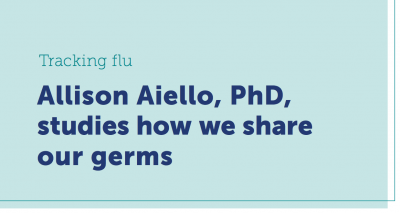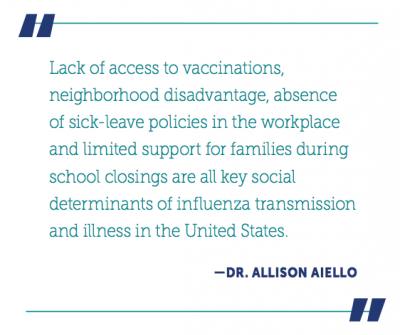Perspectives on the flu: Allison Aiello, PhD
May 15, 2018
 As newspaper headlines proclaimed the winter 2017–2018 flu season the most severe in nearly a decade, the research of Allison Aiello, PhD, has become more timely than ever.
As newspaper headlines proclaimed the winter 2017–2018 flu season the most severe in nearly a decade, the research of Allison Aiello, PhD, has become more timely than ever.
Aiello, professor of epidemiology and social epidemiology program leader in the UNC Gillings School of Global Public Health, is tapping the power of social networks, technology and simple-but-effective interventions, such as hand-washing, to prevent and track transmission of flu. She also examines how policy changes can help reduce the transmission of and disparities in influenza infection.
“My research focuses on nonpharmaceutical methods for preventing flu,” Aiello says. “While the majority of flu work focuses on vaccinations and treatments, I focus on behavioral interventions which, when practiced in the event of a pandemic, may provide an effective first line of defense, especially when pharmaceuticals, such as vaccinations and antivirals, may not be available.”

Evette Cordoba, MPH, epidemiology doctoral student, at left, and her mentor, Dr. Allison Aiello (right), have co-written a journal commentary about the social determinants of flu. (Photo by Linda Kastleman)
Aiello’s research examines social, behavioral and biological factors that have an impact upon infectious diseases and health conditions throughout life. She explores the role of social determinants – e.g., education, race/ethnicity, socioeconomic status, neighborhood-level stressors, and workplace or school policies – on health outcomes.
“Lack of access to vaccinations, neighborhood disadvantage, absence of sick-leave policies in the workplace and limited support for families during school closings are all key social determinants of influenza transmission and illness in the United States,” wrote Aiello and her mentee, Evette Cordoba, MPH, in a commentary published in the North Carolina Medical Journal. “Understanding and addressing these social determinants is essential to reducing the severity of illness and curtailing future outbreaks of influenza.”
Cordoba, epidemiology doctoral student at the UNC Gillings School, and Aiello stress the importance of policy makers’ removing barriers to vaccinations and supporting equitable social policies.
Aiello and colleagues employ technology as an important tool to track transmission of the influenza virus. They worked with the technology company, Ethica Inc., to tailor the company’s existing phone app (iEpi) for tracking college students’ interpersonal interactions to determine how transmission of influenza might be prevented in their social networks.
Aiello says the study illuminated that interpersonal networks are important contributors to transmission of infections and behaviors.
 “We became very interested in being able to better characterize networks so that we could make it easier to identify transmission events,” she says.
“We became very interested in being able to better characterize networks so that we could make it easier to identify transmission events,” she says.
By mapping how people interacted and how that related to their possibility of infection, and comparing self-reported interactions to those collected by sensors, the researchers realized that they were missing “a huge portion” of the interactions that occur.
“Because of that,” Aiello says, “we decided to further our work, using technologies for network data collection. We are working with an engineer at the University of California at Berkeley to implement in our studies a button-sized sensor to allow us to collect data on very, very fine interactions.”
Aiello currently is pilot-testing these sensors in the workplace to examine the relationship of hand hygiene and infectious outcomes in nonclinical office settings.
Hand hygiene and its role in flu prevention is another recent area of research by Aiello.
A study first-authored by Aiello’s mentee Paul N. Zivich, Gillings School epidemiology doctoral student, assesses the effects of hand-washing interventions on infectious disease prevention among employees in nonclinical, office-based workplaces. An article is currently in press in the American Journal of Infection Control.
This work, co-authored by Aiello and UNC under-graduate Abigail Gancz, is a first-of-its-kind literature review to synthesize existing research on the topic.
Shown are a beacon (left) and app that will be used in an upcoming study by Dr. Allison Aiello. Worn or placed in a pocket, the beacon works by Bluetooth ranging. The app allows researchers to log in the beacons as they interact with phones running the app, thereby identifying interactions between study participants. (Photo by Allison Aiello)
The researchers included 11 studies – eight experimental, two observational and one, a simulation – and determined that hand hygiene interventions at various levels of rigor were shown to reduce respiratory and gastrointestinal illness among office employees.
“The interventions examined, such as providing easier access to hygiene products with simple instructional information on proper hand hygiene, were relatively easy to implement,” Aiello says. “That suggests that the potential cost to employers may be moderate to low.”
Aiello served as host and moderator for The 1918 Influenza Pandemic: History, Narrative and Context session during the Gillings School’s Going Viral: Impact and Implications of the 1918 Influenza Pandemic symposium in April.
Socio-economically disadvantaged populations suffered greater rates of infection and deaths during the 1918 influenza pandemic, a disparity that Aiello notes still exists in the United States.
“In general, disadvantaged neighborhoods report lower influenza vaccination coverage and also experience higher influenza-related hospitalizations and deaths,” she says.
“The Going Viral symposium was an important undertaking,” says Aiello. “Retrospective examinations of how epidemics were addressed in the past help highlight ways we might respond more effectively when future pandemics occur. Historical data have been especially useful for understanding the impact of nonpharmaceutical interventions for preventing the spread of flu.”
“The type of research we do, focusing on social and behavioral risk factors and interventions, will continue to be integral in the future. Populations that have access to inexpensive, simple measures to prevent flu transmission will have an added layer of protection before and after vaccination,” Aiello says.
—Michele Lynn
Carolina Public Health is a publication of the University of North Carolina at Chapel Hill Gillings School of Global Public Health. To view previous issues, please visit sph.unc.edu/cph.
